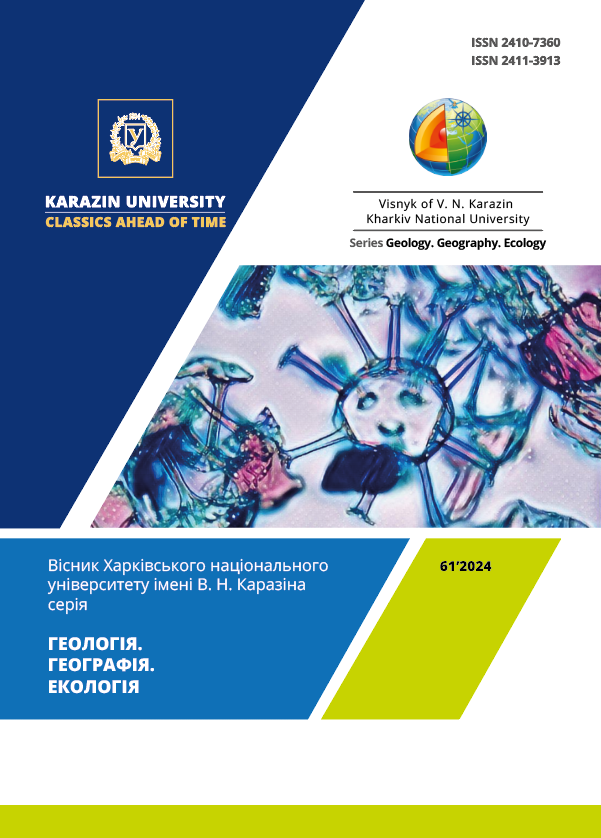Роль турбулентних потоків тепла граничного шару атмосфери у формуванні радіаційних туманів
Анотація
У статті пропонується підхід до прогнозування еволюції радіаційних туманів через визначення турбулентних потоків тепла у шарі туманоутворення. З використанням даних радіозондування атмосфери збільшеної часової дискретності на ст. Lindenberg, сформована база випадків радіаційного туману. На підставі одержаної повторюваності різних типів стратифікації граничного шару атмосфери визначено, що утворення радіаційних туманів супроводжується формуванням приземного затримуючого шару, верхня межа якого коливається у межах від 200 до 800 м. Спосіб розрахунку коефіцієнта турбулентності, який проводився у межах затримуючого шару атмосфери, обраний з урахуванням особливостей температурної стратифікації граничного шару атмосфери і особливостей вертикального профілю вітру при утворенні радіаційних туманів. Одержані значення коефіцієнту турбулентності, осереднені для кожного з обраних для розрахунку шарів, свідчать, що їх максимальні значення спостерігаються в період формування затримуючого шару і туману. Розрахунок величини турбулентних потоків тепла у граничному шарі атмосфери упродовж періоду еволюції туману свідчить, що зміна їх значень у шарі 0-200 м і шарах 200-400 та 400-900 м знаходяться у протифазі. Максимальні значення турбулентних потоків тепла у шарі 400-900 м припадають на строк 00 СГЧ і коливаються у межах від 0,13 до 0,15 кВт/м2 , у той час коли їх мінімальні значення (Qт = 0,02 кВт/м2) спостерігаються за 06 СГЧ на рівні 200 м. Розрахунок часової еволюції теплового балансу підстильної поверхні і граничного шару атмосфери, як різниці між турбулентними потоками тепла і ефективним випромінюванням підстильної поверхні, ідентифікував фізичні механізми трансформації температурної стратифікації граничного шару атмосфери і, водночас, показав доцільність використання цієї величини у якості пре диктора для прогнозу часу утворення і розсіяння радіаційних туманів.
Завантаження
Посилання
Hrushevsky O., Mishchenko O.N. (2023). Forecast of low cloudiness and fog. Study guide. ODEkU, electronic ver-sion, 128. [in Ukrainian]
Efimov V.A., Grushevsky O.N. (2007). On the role of the underlying surface in the formation of atmospheric mesoscale processes over the northern Black Sea region. Bulletin of the Odessa National University. Mechnikova, 12 (8), 80-85.
Koshelenko I.V. (1977). Fogs Proceedings. UkrNIGMI, 155 –215.
Dejmal, K., Repal, V. (2010). Implementation of methods for the radiation fog prediction. – International Journal of Energyand Environment, 4(3), 79-87.
D. Y. Liu, W. L. Yan, S. J. Yang, M. J. Pu, Z. H. Li Niu A. (2016). Study of the physical processes of an advection fog boundary layer. Boundary Layer Meteorology, 158 (1), 125-138.
Liu M., Yan W. L., Zhang B. (2014). Analysis on persistence and intensification mechanism of fog and haze in Jiangsu in January. Meteorological Monthly, 40, 835-843.
Roach, W.T., Back to basics: (1995). Fog. The formation and dissipation of land fog. Weather, 2(50), 7-11.
Stolaki S., Haeffelin M., Lac J.-C. C. (2015). Influence of aerosols on the life cycle of a radiation fog event. A nu-merical and observational study. Atmospheric Research, 151, 146–161.
Li Z. H., Liu D. Y., Yang J. (2011). The microphysical processes and macroscopic conditions of the radiation fog droplet spectrum broadening. Chinese Journal of Atmospheric Sciences, 35, 41–54.
Leichtman D.L. (1956) Some properties of the atmospheric boundary layer. Proceedings of GGO, 56.
Gultepe, I., Tardif, R., Michaelides, S., Cermak, J., Bott, A., Bendix, J., Muller, M.D., Pagowski, M., Hansen, B., Ellrod, G., Jacobs, W., Toth, G. and Cober, S.G. (2007). Fog research: a review of past achievements and future per-spectives. Pure and Applied Geophysics. 164(6-7), 1121–1159. https://doi.org/10.1007/s00024-007-0211-x
Saunders, W.E., (1950). A method of forecasting the temperature of fog formation. Meteorological Society, 76, 2403-2413.
Thierry B., Renaud L. (2019). On the predictability of radiation fog formation in a mesoscale model: a case study in heterogeneous terrain. Atmosphere, 10, 165. https://doi.org/10.3390/atmos10040165
Price J.D. (2011). Radiation fog. Part I. Observations of stability and drop size distributions. Boundary Layer Me-teorology., 167–191. https://www.proquest.com/docview/859504087
Ismail Gultepe. (2012). Fog and Boundary Layer Clouds: Fog Visibility and Forecasting, 1121-1159.
Lang, H.; Qin, K.; Yuan, L.; Xiao, X.; Hu, Y.; Rao, L.; Wang, L. (2016) Particle size distributions and aerosol optical properties during haze–fog episodes in the winter of Xuzhou. China Environ, 36, 2260–2269.
Yang, Y.; Gao, S. (2020). The Impact of Turbulent Diffusion Driven by Fog-Top Cooling on Sea Fog Development. J. Geophys. Res. Atmos. https://doi.org/10.1029/2019JD031562
Niu, S., C. Lu, H. Yu, L. Zhao, J. Lu. (2010). Fog research in China: an overview. Adv Atmos Sci, 27(3), 639 – 662. https://doi.org/10.1007/s00376-009-8174-8
Lakra K, Avishek K. A. (2022). Review on factors influencing fog formation, classification, forecasting, detection and impacts. Rend Lincei Sci Fis Nat., 33(2), 319-353. https://doi.org/10.1007/s12210-022-01060-1
Stolaki, S., Pytharoulis, I. and Karacostas, T. A. (2012). Study of fog characteristics using a coupled WRF–COBEL model over Thessaloniki airport, Greece. Pure and Applied Geophysics., 169(5-6), 961–981. https://doi.org/10.1007/s00024-011-0393-0





